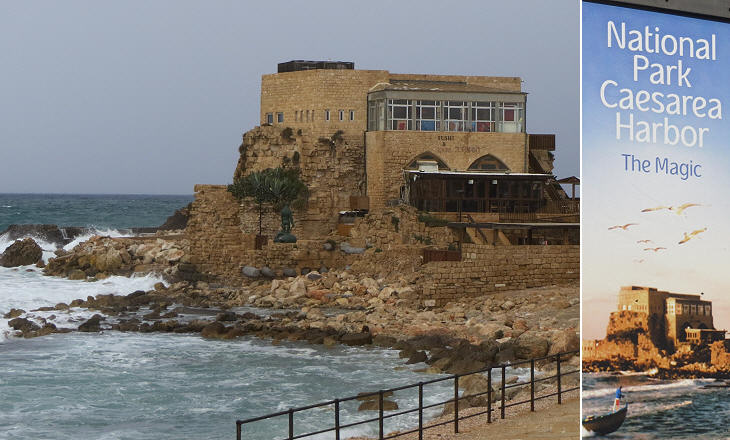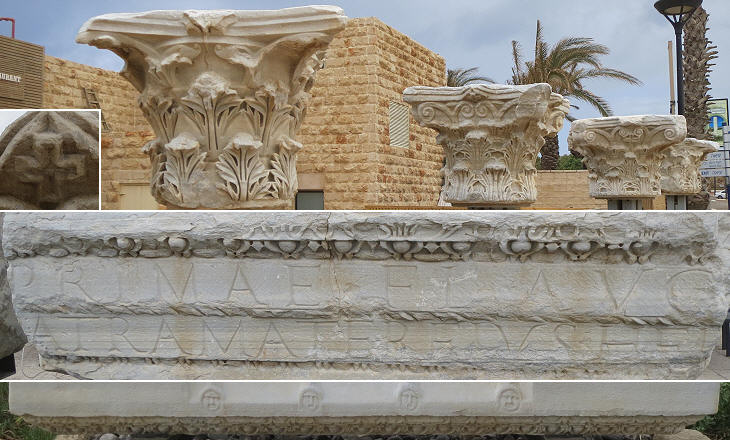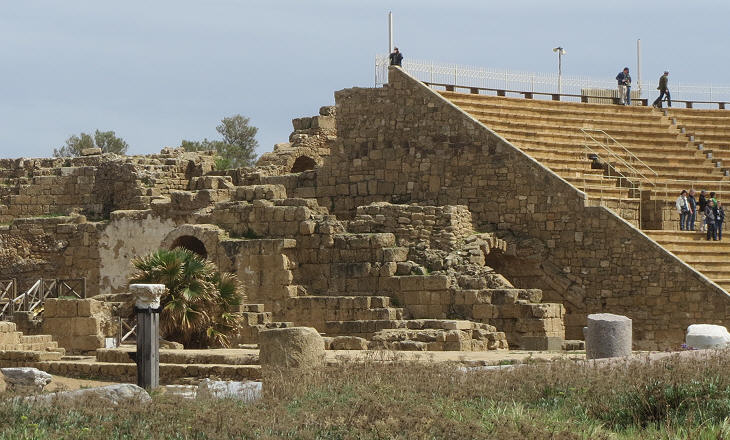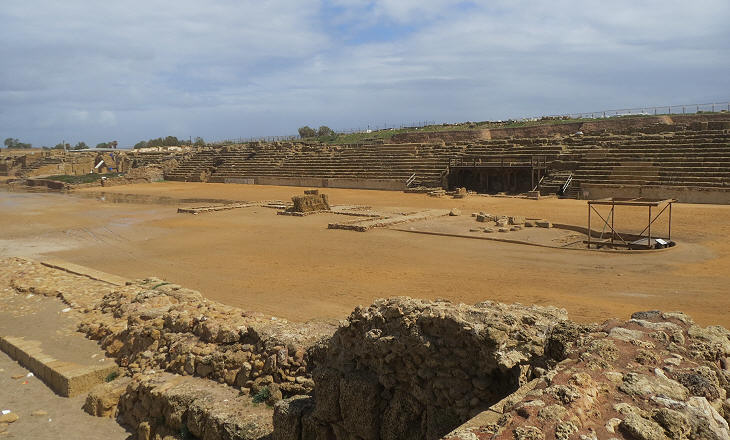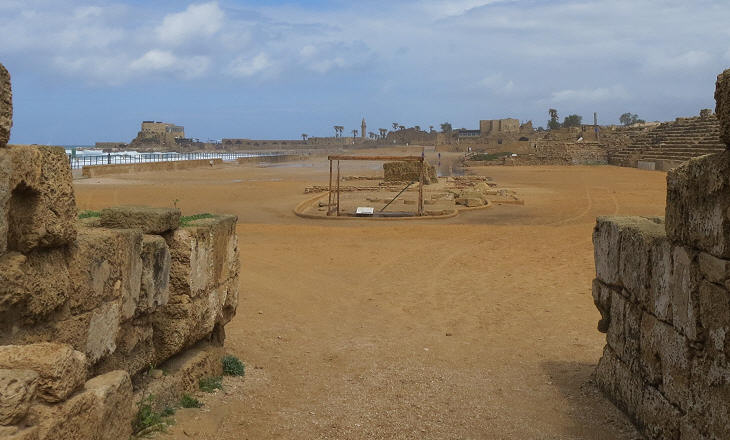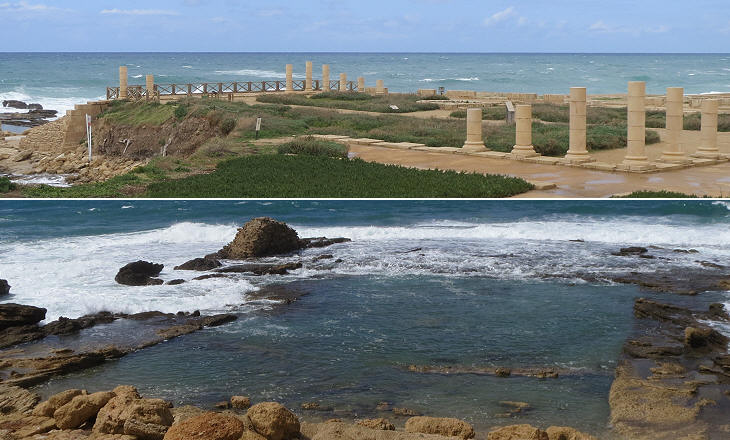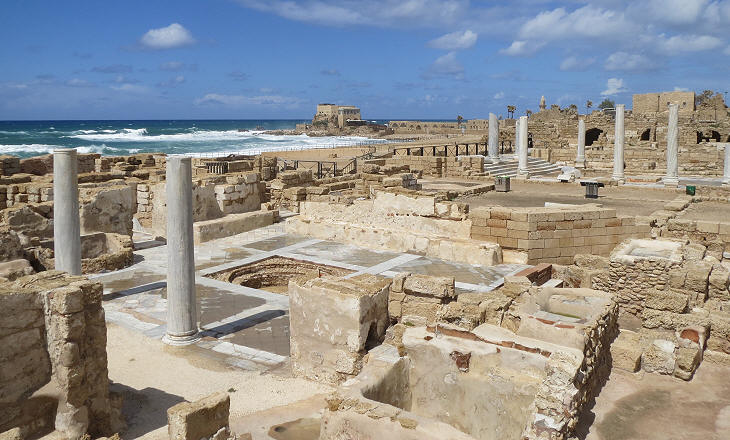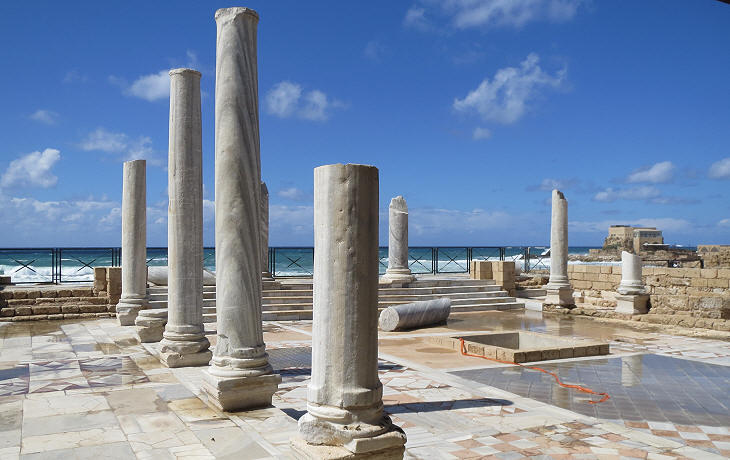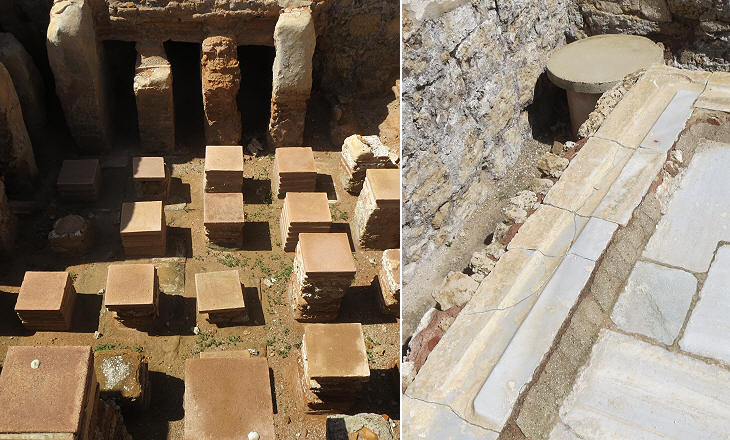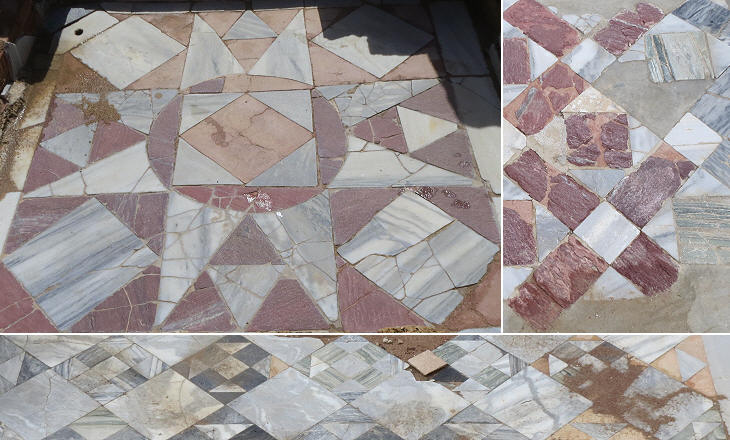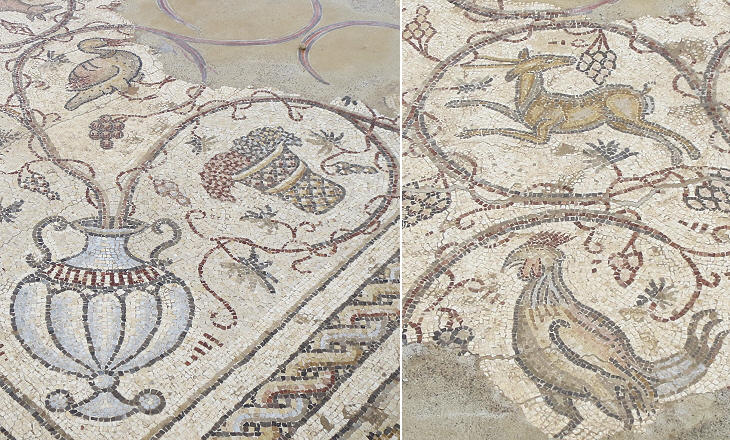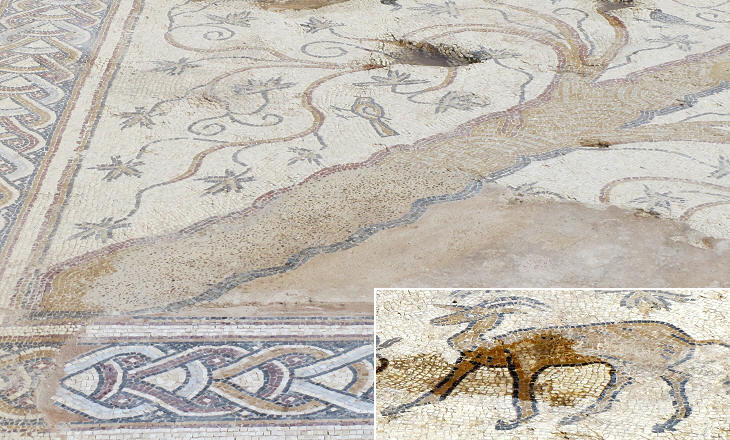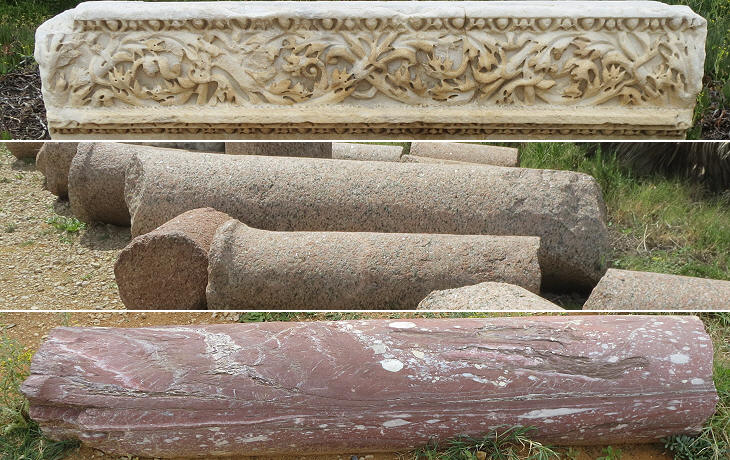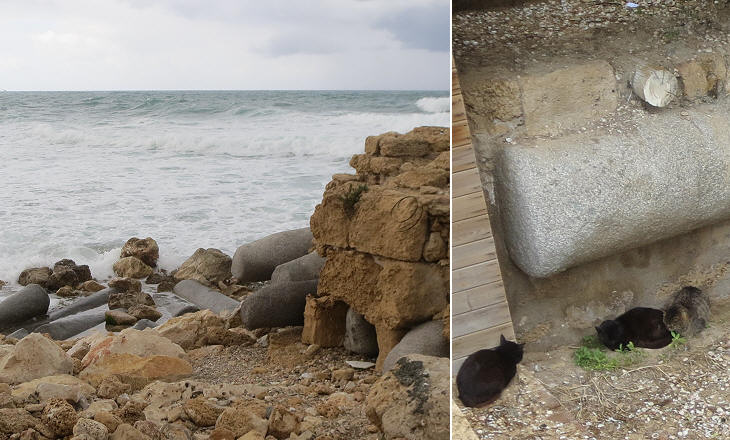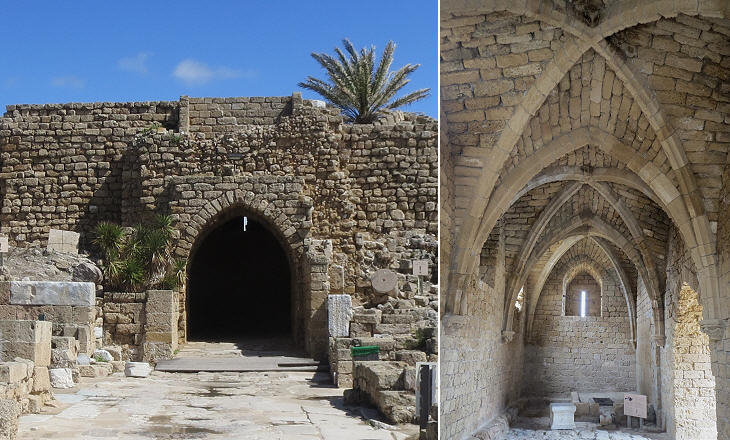  What's New! Detailed Sitemap All images © by Roberto Piperno, owner of the domain. Write to romapip@quipo.it. Text edited by Rosamie Moore. Page added in July 2013. |
 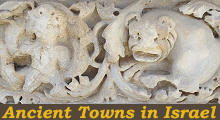 - Caesarea Maritima - page one - Caesarea Maritima - page one(relief at Scythopolis) Pompey made them (the maritime cities) subject to him (..) Gaza and Joppa (Jaffa) and that which was anciently called Strato's Tower, but was afterward rebuilt with the most magnificent edifices, and had its name changed to Caesarea by King Herod (Herod the Great, King of Judea in 33-4 BC). (..) And when King Herod observed that there was a city by the sea-side that was much decayed, (its name was Strato's Tower), but that the place, by the happiness of its situation, was capable of great improvements from his liberality, he rebuilt it all with white stone, and adorned it with several most splendid palaces; for the case was this, that all the sea-shore between Dora (a Phoenician port south of Mount Carmel) and Joppa, in the middle, between which this city is situated, had no good haven, insomuch that every one that sailed from Phoenicia for Egypt was obliged to lie in the stormy sea, by reason of the south winds that threatened them. (..) But the king, by the expenses he was at, and the liberal disposal of them, overcame nature, and built a haven larger than was the Piraeus at Athens. Flavius Josephus - The Wars of the Jews - Translation by Samuel Burder Josephus was the leader of the First Jewish Revolt in Galilee and in 67 AD he was captured by Roman general Vespasian who became emperor two years later. Josephus, who had prophesied the event, became an adviser to Titus, Vespasian's son, during the rest of the campaign. He was eventually freed and, consistent with Roman usage, he added the "surname" of his patrons (gens Flavia) to his name. He then wrote several books (in Greek) on the history of the Jews which were meant for a Roman audience, but nonetheless are the main source of information for historians on many events which occurred during the First Jewish Revolt and in the century which preceded it.
Maintaining an archaeological site is a complex and expensive task: walls which crumble, frescoes and mosaics which lose their original colours and small decorative marbles which are stolen are some of the headaches managers in charge of the sites have to cope with. The approach developed at Caesarea is unfortunately a cure which is worse than the disease. All the area of the ancient town inside the walls built by King Louis IX of France in 1254 has been turned into an expensive beach resort with cafés, restaurants and shops.
Capitals, lintels, inscriptions and sarcophagi, rather than being housed in a museum and grouped by chronological order and style with appropriate background information, have been used to embellish the commercial area as flower pots. At the ticket office a leaflet is given which illustrates the many shopping opportunities the site offers, all of which are unrelated to the past of Caesarea.
A Roman theatre is the second highly publicised attraction of Caesarea. Unfortunately only a small section of the theatre has been preserved. Rather than building a temporary structure at the side of the ruins for housing operas and other musical performances, managers have chosen to bury the ancient walls with a flow of concrete. It is difficult to understand how such a modern facility could be evocative of the ancient past. The municipality of modern Caesarea has been entrusted to a private organisation which has developed around the archaeological area one of the most upscale residential communities of Israel. This organisation clearly regards the theatre as an amenity similar to the golf course or the country club it offers its residents (including influential politicians such as Benjamin Netanyahu). It is fair to say that other archaeological areas in Israel (e.g. Scythopolis) have been restored and are maintained with respect for their past.
King Herod also built the other edifices, the amphitheatre, and theatre, and market-place, in a manner agreeable to that denomination (Caesarea); and appointed games every fifth year, and called them, in like manner, Caesar's Games; and he first himself proposed the largest prizes upon the hundred ninety-second olympiad; in which not only the victors themselves, but those that came next to them, and even those that came in the third place, were partakers of his royal bounty. Flavius Josephus At Jerusalem King Herod showed his allegiance to Jewish religion by redesigning the Temple, but at Caesarea, a new town without a historical Jewish background, he entirely displayed his desire to introduce the ceremonies and the way of living of the Greco-Roman world in his kingdom. The origin of the town caused a quarrel between its Jewish and Hellenised inhabitants: The Jews pretended that the city was theirs, and said that he who built it was a Jew, meaning King Herod. The Syrians confessed also that its builder was a Jew; but they still said, however, that the city was a Grecian city; for that he who set up statues and temples in it could not design it for Jews. Flavius Josephus. The addition of Maritima to the town's name was due to the existence of many other Caesarea (Caesarea Cappadociae - Kayseri, Neocaesarea - Niksar and Caesarea Philippi or Paneas - Banias to name just those covered in this website).
Eventually Caesarea became the residence of the Roman governor of the Province of Judea and some of the buildings erected by Herod were modified or entirely replaced. A facility along the seaside was most likely the first hippodrome of Caesarea. At one point it was turned into an amphitheatre and a large hippodrome was built in an area which is outside the archaeological park.
The seaside resort and beach holiday, (..) just as factory industry, steam power, modern means of transport and other innovations of the Industrial Revolution era trace their origins to developments in Britain.(..) From the late nineteenth century, modern tourism is another familiar set of phenomena that, for better and worse, the British gave to the world. The tentacles of the global tourist industry now embrace phenomena like sport and nostalgia for industrial pasts, but the seaside resort remains at the core of its imagery, both contemporary and historical. (..). The nostalgia dimension is fitting, given that it all began in Britain, in that eighteenth century that also saw the origins of the more conventional Industrial Revolution, although, as with so many other innovations the British gave to the world, the Romans had already been there nearly two millennia earlier. John K. Walton - The Seaside Resort: a British Cultural Export. The Roman emperors, especially those of the first "dynasty" loved to live by the sea, to swim in it, but not to sunbathe and they built artificial caves to stay in the shade. Augustus had a villa at Baia, near Naples, Tiberius at Capri and at Sperlonga, south of Terracina and Nero at Antium. We do not know the name of the Roman or local personage who lived on a residence built on a small promontory between the theatre and the amphitheatre at Caesarea, but he definitely loved the sea and probably even more on a day of rough sea as the one during which I was there.
A large complex of baths was built behind the amphitheatre in the IInd or early IIIrd century AD. It was supported by vaulted structures which perhaps were used as warehouses. The walls of the main halls have vanished. Their bricks and stones were most likely removed in the XIIIth century to build the fortifications of the small Crusader town around the harbour.
The size and luxury of the baths were important for the citizens of a town of the Roman Empire as the size and decoration of their cathedral was for the inhabitants of a European medieval town. The baths of Caesarea were decorated with marbles coming from very remote locations of the Empire. Their design was widely similar to other baths. A regular visitor of the baths of Roman Carthage or Sabratha would have found himself at home at the baths of Caesarea.
The precondition for the existence of such a large bath complex was the availability of water. An imposing aqueduct (see page two) carried water to the town to supply monumental fountains and public baths and eventually to drain out the waste through sewers.
Initially the marble inlays which decorated many Roman buildings were the by-products of columns which broke during transportation. In the late IInd and IIIrd century their presence indicated the re-use of earlier building material, known as spolia. A much popular combination of coloured marbles was based on the use of green, red and grey slabs (you may wish to see the baths of Villa dei Quintili or some marble inlays at Villa Adriana, both near Rome).
Several floor mosaics have been found at the Baths and in nearby buildings. Caesarea was a prosperous town at least until the mid of the VIth century, when most of its population was Christian and the Byzantine emperors had passed bills to destroy all references to the ancient gods. This explains why the mosaics which have survived to the present time do not portray pagan gods or heroes. Mosaics depicting a grapevine growing from a "Kantharos", a cup used for drinking wine were probably associated to Dionysus , the Greek god of wine-making (you may wish to see a mosaic at Delos), but the Christians turned them into a symbol of life (as at the Baptistery of Bellator at Sufetula in Tunisia).
It required a talented pictor musivarius (the mosaicist in charge of executing the central panel of a mosaic) to depict a kantharos such as that at the Museum of Thysdrus in Tunisia, so the pictor musivarius who made the mosaic shown above took a shortcut and replaced the vessels with easy to draw trees. He added however a local touch by depicting a pair of oryxes, an Arabian antelope which today is almost extinct in nature.
Those who wanted to decorate public or private buildings with mosaics could choose from a large catalogue of geometric patterns, which can be found throughout the whole Roman Empire as if the guild of mosaicists had an internet website for sharing images among its members. In Rome, rather less in the provincial towns, black and white mosaics were popular for their optical effects as at Villa Adriana.
Build (or make) to stock is a production technique which was developed by British manufacturers in the XVIIIth century, in contrast with build to order which was the traditional approach. It is likely that in the IInd and IIIrd century a similar technique was implemented by the sculpture workshops of Afrodisias, a town in Asia Minor which provided the whole empire with standard sets of decorated lintels. The same approach was perhaps adopted by some quarries which produced highly requested stones. The image used as a background for this page shows the head of a Gorgon (a charm against ills) on a sarcophagus in the modern commercial area inside the archaeological one.
In the VIIth century Caesarea was conquered by the Arabs and it soon lost importance as a trading centre. Without proper maintenance its harbour silted. It was conquered by the Crusaders in 1101, but in 1187 Saladin seized it after having conquered Jerusalem. In 1191 the Crusaders returned to Caesarea and held it with some intervals until 1265, when Mameluke Sultan Baibars managed to overcome the small garrison after a short siege. In 1291 he decided to raze the town to the ground. The site was abandoned until 1884 when the Ottomans built a small village for Muslim refugees from Bosnia inside the medieval walls.
King Louis IX of France was the very unfortunate leader of the Seventh Crusade. In 1249 he landed at Damietta with the objective of conquering Egypt and then move towards the Holy Land, but in the following year his army was defeated and he was taken prisoner. Released after the payment of a huge ransom, he proceeded to Acre, the main remaining Crusader possession in the Holy Land. He promoted the strengthening of the fortifications of Acre and Caesarea before returning to France in 1254. You may wish to see a section on the fortresses built by the Crusaders in the Levant. Move to page two: Caesarea outside the medieval walls Move to: Introductory Page Ancient Synagogues: Introduction, Korazim, Capernaum and Hamat Teverya Ancient Synagogues: Bet Alpha, Diocaesarea and Ein Gedi Diocaesarea (Zippori) Herodion Mamfis (Mamshit) Masada Megiddo Necropolis of Bet She'arim Oboda (Avdat) Scythopolis (Bet She'an)  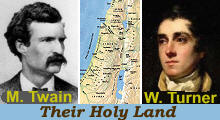 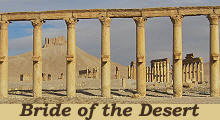 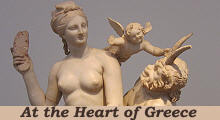 |
